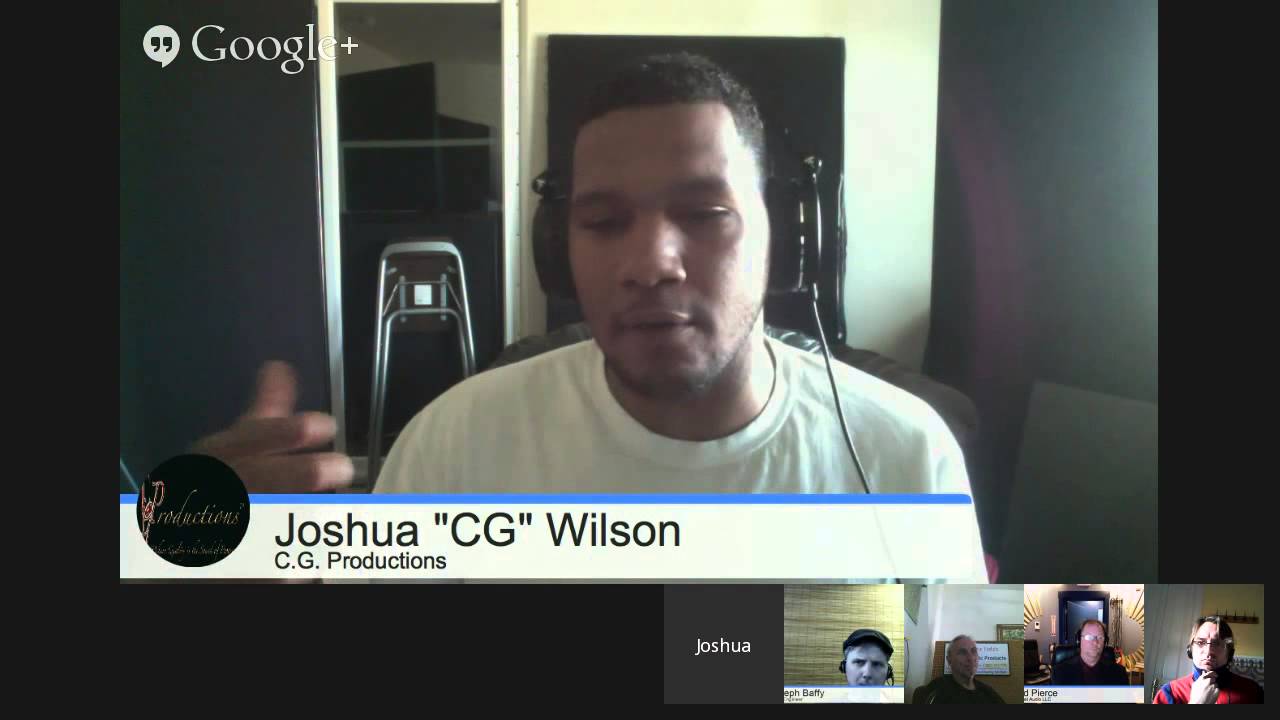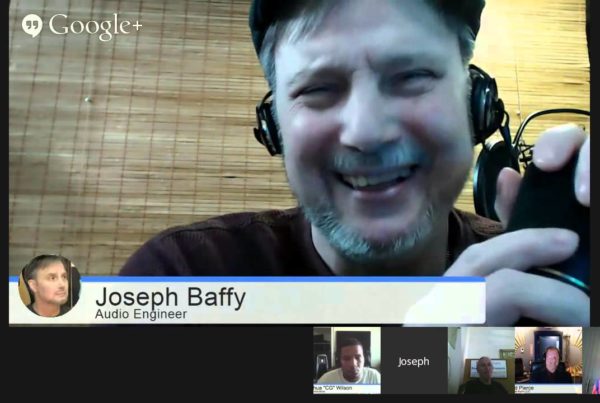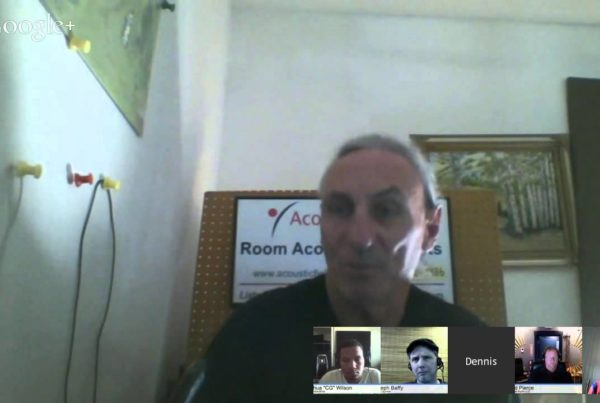In another of our monthly Google Hangouts with experienced and talented audio engineers Brad Pierce, Joseph Baffy and Joshua Wilson, we continued in our efforts to bridge the gap between what you are hearing as an engineer and how the room is causing that problem. The following video and transcript comes from one particular section where we addressed the issue “Acoustic Guitar Mic Placement & Room Acoustics”. If you would like to see the full hour and a half discussion you can see the video further down the page.
Dennis: Well it just seems to me that you know when I design rooms obviously I have to squeeze every bit of information out of that recording and there’s some recordings that I almost think you know “don’t play in this room, you’re banned, you can’t get in the room anymore”. I was thinking about that the other day and I have all these CD’s in my room and how many do I really use when I give a demonstration? I use two. And you know what’s funny about it these two were recorded for me, they’re not standard you know. Recordings that are mass market sold. The engineer who put this together for me you know I guess he went on the extra mile and maybe we’re not seeing that today. And I’m sure it’s amplified in my room because there’s nothing you’d miss in my rooms. So maybe my room’s just too good for the source.
Ali: Well yeah I had that experience in your room for sure. One of my favorite albums ruined for life.
Brad: You want to share that with us?
Ali: Well I don’t want to name it but I think they clearly mixed it in possibly the worst room in the world because they clearly weren’t hearing what we heard. Everything was in the middle and there was nothing across the spectrum.
Joseph: You just said the key to everything, to all of this. They weren’t hearing what you guys heard. When they are mixing that album. Well, it’s about the space that they are in, probably didn’t allow them to hear you guys were hearing.
Brad: You can only makes decisions, mix decisions, on what you’re listening to. So if you’re missing stuff, if it’s not apparent that it’s there, you can’t do anything about it so if it’s an error, or something sticks out or whatever, you can’t adjust it and fix it. When you release the CD or you go to your car or you go to some other monitoring source, it may stick out there. But still you know your other monitoring sources, you know your auto toner, your S10 something like that, you may not still hear things that are in there.
So if you have a room like Dennis has, and you’re listening, you’re going to hear everything as it is. So then you can make good decisions about what you’re doing. That’s the end game, that’s the desire when you’re mixing, mastering as well.
Joshua: Yeah I agree with that. I think a lot of it as well also the sources of audio that you have because if you record in a good environment, even though there’s things that you may not hear but there’s things that you may not necessarily need to hear. Know what I mean? So like the treatment that we just had in the vocal booth here, like the vocals that I’m getting now are a lot fuller than before. Know what I mean? And we’re not going too deep into it. There’s so many different things that have to do instead of like it’s not just listening for me now. There’s things that I feel in the audio now. I have to go on adjustments on how I’m feeling instead of what I’m hearing. And this is all about what you have in the environment of where the source the audio is coming from.
Ali: That’s going to be interesting discussion ‘cause see feeling rather than hearing now.
Joshua: Yeah.
Dennis: Isn’t that’s what is supposed to be about? Where did that get lost?
Joseph: Somewhere at the bank.
Dennis: I think somewhat you’re right Joseph. I think somewhere between the studio and the bank.
Joseph: Yeah very possible. There’s a commercial that I watch. It’s a product that is being offered to kids that has stereo pair of microphones in it and a guitar input and a headphone output and monitor outputs and it’s this I’ve never held it in my hand but it looks like it’s a about the size of a big condenser microphone. And they show some young man tapping on a mailbox and clapping their hands on a big atrium and hit it with some other freaking trash can or something you know spanking a piece of glass inside of a building. And then this gets morphed into this beautiful sounding pop song and I don’t think that is a message that is very good. Legally you’re allowed to do that but I don’t think that’s a very accurate message and I really don’t think that’s a very common that you’re going to be able to hit a garbage can or clap your hands and you’re going to have a bass drum and snare and it’s going to work really good. Especially if you have a crappy song that you just wrote now you’re going to use a bunch a crappy source material to try to create a tune.
Now, that being said I’m not doging anybody. But I’m just pointing out the message to any young man it doesn’t matter of your age, any person who is new to the business who’s listening, that is a rarity, that commercial is showing you 1% of something of the picture. 99% of the other rest of the picture is a bunch of fails. It’s not working. A 200 dollar microphone is not going to pick up every single thing that you want to record and the best possible way it can be done. It might be usable and you might get a really good demo out of the deal but it’s generally not going to be what this commercial plays back at the end. And it plays back something that sounds to me like it was not recorded with a hundred dollar microphone and you know in an atrium and a trash can. It doesn’t seem like a very true picture.
Brad: I kind of agree with that. I think when you’re talking about gear, microphones, transducers, the capability of a particular item can be used to its fullest or you can shortchange it by doing things that you shouldn’t be doing. But as that capability climbs, obviously you know the price tag might go up but as long as you’re using the equipment that you have to its fullest capability that is the maximum quality that you’ll be getting. Obviously, increasingly the capability of the item that you’re using, the outcome will be a better quality.
Joseph: This is a good example of what I would consider mediocrity crap. This is an Excel 770. I bought three of these to use as donor bodies. You know to try to teach myself how to make really good microphone. The first two I ruined ‘cause I didn’t know what I was doing, they sound worse than when I started. But this particular one sounds fantastic. I mean I wish I could’ve documented what I did to make those one good.
Brad: But it’s nice.
Joseph: Yeah it is really nice. I’m really grateful that it came out. So I hear what you’re saying. If you utilize whatever gear you have to its fullest potential and then some, you can really, really do some good stuff but it will come back to the environment. And you’re being cognizant of what happens in the environment. I would urge anyone to learn the basics. I think Dennis’ videos that he does are fantastic. He’s trying to reach out and show people like hey this stuff exists whether you want to see it or not. The distortion between your speaker box and the wall, it exists. And you can’t just put phone in a corner and think it’s going to you know change something for the better.
I mean well it does, I should not and will be so harsh. It will change something, for sure. But it’s not changing what you think it is going to change. The message on the tin is a little misleading and we’re back to where we were last month. The more people who hear this, the more folks who are able to watch your 5 minute presentations and get an inkling to actually read and understand, and they don’t have to become an acoustician but just to understand that these principles are like gravity, they exist, they’re there and they won’t go away. They’re always there.
In Summary
To learn more about room acoustics and how drums interact with your room, please sign up to download our free ebooks and video series on room acoustics here. And please let me know if you have any questions at any time.
Thanks
Dennis Foley







